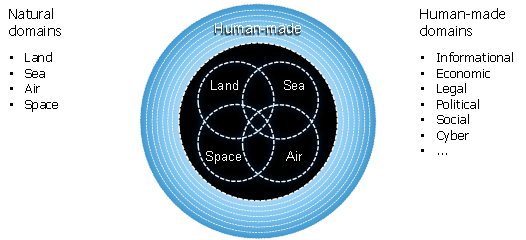When we think of military operations, we picture soldiers on the ground, ships at sea, jets in the sky or satellites in orbit. The traditional domains of warfare, land, sea, air and space, each have a dedicated military force. In recent decades, cyber was added to the list, recognizing the strategic importance of digital infrastructure and information networks.
But, what if we’re missing something bigger?
The nature of conflict is evolving, and so must our understanding of the “battlespace.” In this digital, globalized age, operations aren’t confined to physical terrain. They increasingly occur within systems designed and shaped by people (economic markets, political structures, legal frameworks, and online social platforms). These are what can be called human-made domains, and they’re becoming just as critical to national security as any physical territory. Recognizing these domains as operational spaces enables U.S. forces to compete, influence, and prevail well left of conflict.

Figure 1. Interrelationships between natural domains and a set of representative human-made domains, where the overlapping natural domains of land, sea, air and space form the core, around which are many human-made domains.
What is a ‘Domain’?
Traditionally, maneuver has meant physical movement: taking the high ground or exploiting gaps in the front line. But in today’s strategic environment, maneuver must also mean shaping narratives, disrupting financial systems, influencing legal norms, or manipulating digital flows of information.
Human-made domains are “macro maneuver spaces, “places where access and control translate directly to freedom of action. If you're a joint force commander, an interagency planner, or an information operations lead, understanding these domains lets you:
- Target decisive points beyond the battlefield (e.g., financial choke points, regulatory bodies, social influencers).
- Synchronize non-kinetic and kinetic actions for multi-domain effects.
- Detect and exploit adversary vulnerabilities that don’t exist on a map—but do exist in legislation, networks, or economic dependencies.
Why This Matters
Data tells the story. Over the past few centuries, the human population has exploded, and so has the complexity and scale of the systems we rely on. Consider:
- Global GDP has grown exponentially, reflecting the rise of complex financial systems.
- Electricity generation, especially to support data centers and AI, has surged.
- Internet and social media use now reach billions, creating vast new spaces for influence and disruption.

Figure 2. Indices for human-made domains are increasing nonlinearly along with world’s human population. (https://ourworldindata.org/world-population-growth; A: https://data.worldbank.org/indicator/NY.GDP.MKTP.KD; B: https://visualizingenergy.org/world-electricity-generation-since-1900; C: https://data.worldbank.org/indicator/IT.CEL.SETS; D: https://ourworldindata.org/internet; E: https://ourworldindata.org/grapher/users-by-social-media-platform; F: https://ourworldindata.org/land-use)
These aren't just statistics, they’re signals that where and how we operate is changing. What used to be “supporting terrain” is now contested space. What used to be strategic background is now strategic foreground.
The Concept of Maneuver
To operate effectively in this new landscape, we need a broader framework for maneuver. One proposal is MAN^N, or “Maneuver in N Dimensions.” It’s a way to describe synchronized operations across not just the physical (land, sea, air, space, cyber), but also the informational, political, economic, legal, and social dimensions of conflict.
In practical terms, MAN^N helps planners and operators:
- Map terrain in the legal or information environment the same way we map roads or satellite orbits.
- Identify and seize “positions of advantage” in digital, social, or regulatory systems.
- Coordinate diplomatic, informational, military, and economic tools (DIME) for converging effects across the competition continuum.
For example:
- In cyber, decisive points might be both a physical data center and a high-reach social influencer.
- In lawfare, maneuver might involve shaping international legal precedent to legitimize a gray zone operation.
- In economic operations, it could mean pressuring a strategic supply chain node through coordinated sanctions.
What’s Next?
We already have distinct military branches for land (Army), sea (Navy), air (Air Force), space (Space Force), and cyber (Cyber Command). As our dependency on human-made systems deepens, is it time to consider a dedicated force focused on operations in these emerging domains?
Some argue that cyber operators could expand their scope. Others envision new roles or hybrid teams drawing on expertise in economics, law, psychology, and more.
Understanding human-made domains is not academic. It’s operational. It enables earlier action, broader influence, and smarter competition. Advantage comes from understanding the whole terrain. We’re in an era where a denial-of-service attack, a viral TikTok, or a well-placed legal ruling can have as much operational impact as a missile strike.
By embracing human-made domains as operational spaces, the U.S. military, and the broader national security community, can better compete below the edge of armed conflict, impose costs in new ways, and shape the environment before it escalates.
This is not about redefining war, it’s about expanding maneuver to match the world as it is.
The viewpoints, opinions, and conclusions expressed in this article are those of the author(s) and do not necessarily reflect the policies, positions, or endorsements of ARLIS, UMD, or any affiliated organizations. The content provided is for informational purposes only and should not be construed as representing the views of any funding agency.
